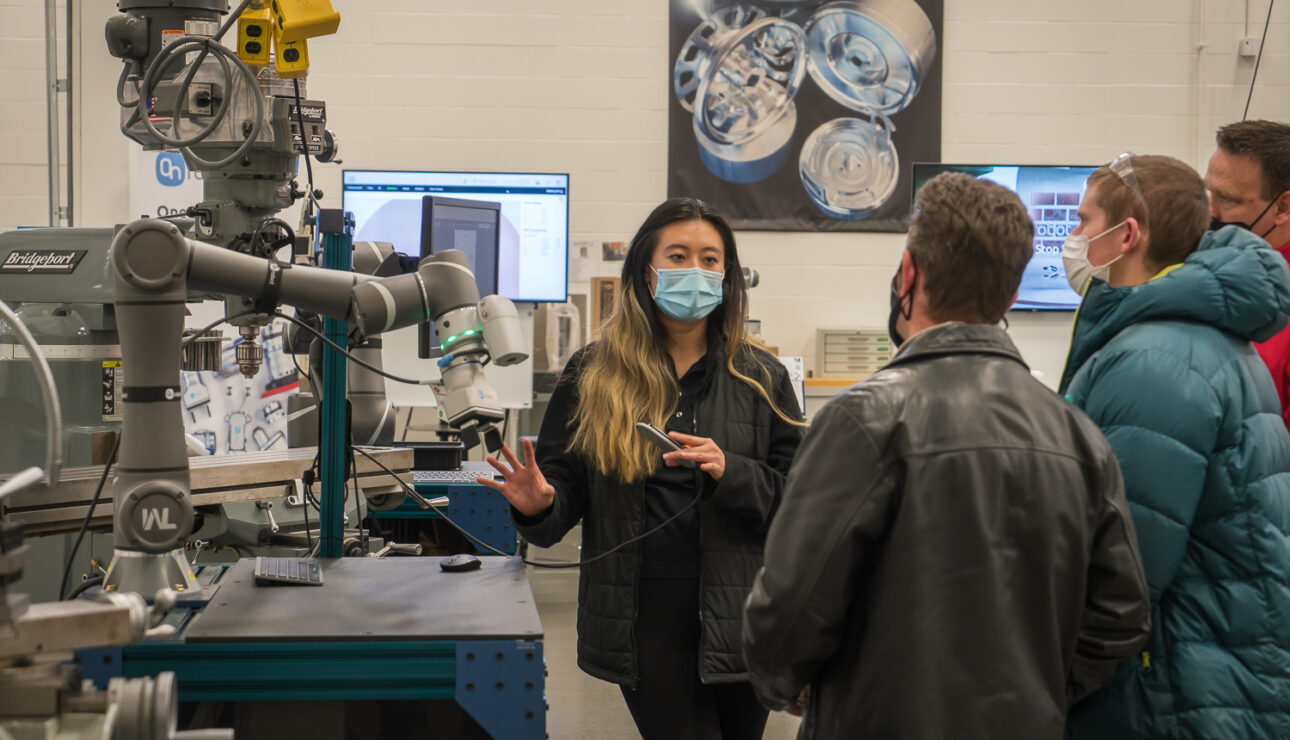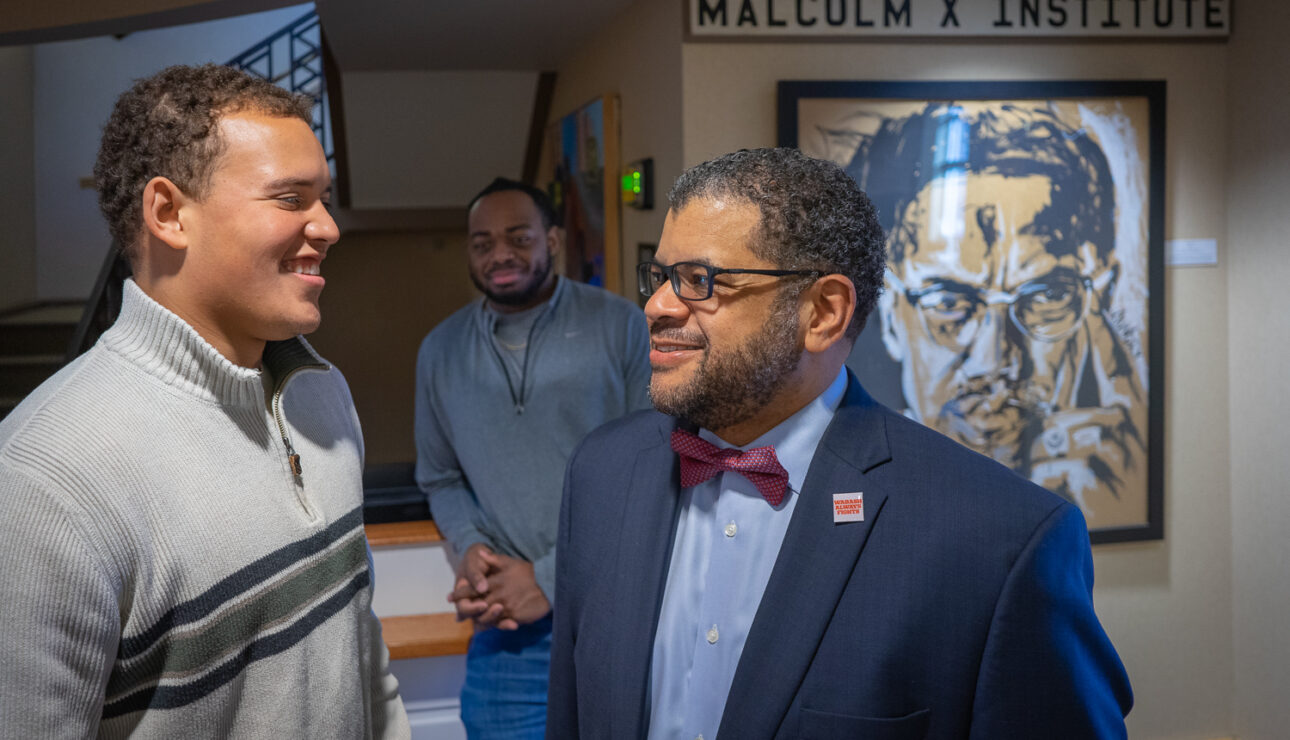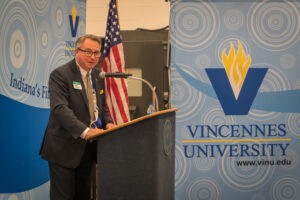Higher Ed Responds to Changing Realities
2021 Annual Report:
Indiana Colleges and Universities are Responding to Urgent Call to Reimagine Higher Education
Higher education may be facing its greatest challenges in more than a century. Demographers, economists, business leaders and college presidents themselves are seeing and experiencing trends that promise to change dramatically postsecondary education, if not significantly disrupt it.
Across the nation higher education institutions are preparing for a steep decline in enrollment as projections portend demographic shifts and fewer young people of traditional college age. A higher proportion of that smaller group of young adults will be persons of color, individuals representing more diverse ethnic backgrounds, members of families with lower incomes and first-generation college students—students who are and have been historically underserved by higher education. To thrive, colleges and universities recognize that they must adapt and work to become more inclusive and more effective in serving all students.
And the exploding digital and knowledge economy has brought often disruptive innovation to higher education. New online options increasingly rival the in-person paradigm that has served higher education in the United States in the past.
Any one of these changes would spark soul-searching for colleges and universities. Several occurring simultaneously elevates the stakes for institutions and illuminates the urgent need for innovation.
Recognizing these opportunities and challenges, Lilly Endowment in 2019 launched Charting the Future for Indiana’s Colleges and Universities. Through the three-phase initiative, the Endowment invested $138 million to encourage Indiana colleges and universities to prioritize the challenges and opportunities they face to fulfill their educational missions in light of rapid economic, demographic and technological changes and the evolving needs and demands of students.
Charting the Future is the “most thoughtful, forward-looking and comprehensive” initiative in the nation, says Arthur Levine.

Levine (right), studies higher education at New York University and the Institute for Citizens and Scholars. In 2021, he authored with Scott J. Van Pelt “The Great Upheaval: Higher Education’s Past, Present, And Uncertain Future,” a bird’s-eye view of the higher education landscape. The Endowment’s vision is particularly apt for the times, Levine says. Because it encompasses all of Indiana’s colleges and universities, which could produce many ideas and best practices with potential to become the new normal through the digital age.
Through Phase 1 of the Charting the Future initiative, the Endowment made planning grants ranging from $100,000 to $500,000 to each of Indiana’s colleges and universities based on enrollment. Phase 2 grants ranging from $1 million to $5 million, also based on enrollment, enabled the schools to implement their ideas.
The $62 million distributed in Phase 2 will support broader in-demand degree offerings in health sciences, deeper connections and stronger alignment with local schools and other community-based organizations focused on education, better access to and utilization of technology for teaching and learning, more mental health services for students in response to growing cases of anxiety and depression on campuses, improved recruitment and student retention, and enhanced diversity, equity and inclusion efforts, among other programs and strategies to serve students and strengthen institutions.
The final, Phase 3, distribution of $69.9 million was allocated through 12 grants—spanning $2.7 million to $10 million—to 16 schools and supporting nine large-scale projects. Some of these projects were highly collaborative, involving multiple schools, which was encouraged through Charting the Future.
Charting the Future Phase 3 grants are supporting efforts on the following campuses: Anderson University, Butler University, DePauw University, Goshen College, Indiana Institute of Technology, Indiana State University, Martin University, Purdue University, Rose-Hulman Institute of Technology, Saint Mary-of-the-Woods College, University of Evansville, University of Indianapolis, University of Southern Indiana, Valparaiso University, Vincennes University and Wabash College.
Indiana colleges and universities responded to Phase 3 of the Charting the Future initiative by proposing strategies that include:
- Engaging adult learners with new educational offerings, including certificates and credentials that recognize skills and knowledge valued by employers.
- Partnering with K-12 schools to offer collaborative programs and improve college readiness.
- Improving mental health services for students through a three-school collaboration.
- Attracting and better serving and retaining more Black and Hispanic students through campus- and community-wide programming.
- Increasing overall student retention through better and intensive counseling and predictive analytics to develop and implement targeted interventions.
- Improving career readiness through employer partnerships, especially with Indiana companies in search of new talent.



In November 2021, the Endowment in connection with the initiative convened leaders from all of Indiana’s 38 colleges and universities. During the one-day meeting in Indianapolis, institutional presidents, provosts, deans and others gathered to learn how Charting the Future efforts are taking shape on campuses across the state. And they came together to hear from national higher education experts, including Levine and Shaun Harper, a professor in the schools of education and business at the University of Southern California (USC).
Harper, who is founding director of the USC Race and Equity Center, urged Indiana’s higher education leaders to view improving equity on their campuses as mission critical. Since 2003, he and fellow researchers have helped 300 colleges and universities nationwide conduct “climate assessments” to learn the state of diversity, equity, and inclusion (DEI) on campuses.
The process requires people to learn to talk about race, something that many people in higher education—students and faculty alike—never learn how to do, Harper says. Once prepared to talk about and learn about race, leaders can begin to examine all aspects of higher education—from admissions to financial aid, curricula to hiring, student life to board governance—with a commitment to making campuses places where all people are welcome, included and able to learn and contribute. He challenged Indiana higher education leaders to treat DEI work with the kind of strategic attention they give to their institutions’ financial well-being.
Convening participants also learned from a panel of Indiana CEOs, moderated by Indiana higher education commissioner Teresa Lubbers, that included Connie Bond Stuart from PNC Bank, Jeff Harrison from Citizens Energy Group and Tom Linebarger from Cummins. They talked about the skills and other qualifications business leaders look for when filling roles in their organizations. And attendees spent time in moderated peer discussions exploring ideas on issues such as DEI, student retention, adult education and career readiness—all issues identified as priorities by college presidents.

Indiana higher education leaders gathered in Indianapolis in November 2021.
Charting the Future is designed to foster a future in which higher education enables Hoosiers to thrive in a society facing rapid technological, social and economic change. The following are six examples of promising efforts underway at Indiana schools supported by Phase 3 grants.
“We can chart a future where campuses are more equitable, more inclusive. But we have to teach people what to do, how to do it and how to sustain it.”—Shaun Harper, founding director, University of Southern California’s Race and Equity Center.
Featured Projects
Restoring Hope, Restoring Trust
Wabash College (Crawfordsville)
$4.5 million
The Endowment’s Phase 3 grant is bolstering efforts already underway on several fronts to improve diversity, equity and inclusion. Wabash concluded years ago that improving DEI efforts in curricula, training and leadership offerings, among other efforts, would attract quality faculty, staff and students, thus preparing the institution to thrive well into the future.
 “The grant is a guiding light,” says Jill Lamberton (right), Special Assistant to the President for Diversity, Equity and Inclusion at Wabash. “It enables us to simultaneously focus our diversity, equity and inclusion efforts on faculty and staff development, student recruitment and retention, campus climate, community engagement and multiple collaborations.”
“The grant is a guiding light,” says Jill Lamberton (right), Special Assistant to the President for Diversity, Equity and Inclusion at Wabash. “It enables us to simultaneously focus our diversity, equity and inclusion efforts on faculty and staff development, student recruitment and retention, campus climate, community engagement and multiple collaborations.”
Within five years Wabash intends to increase four-year graduation rates by 20 percent for traditionally marginalized students—those from low-income, new majority and first-generation college families. Enrollment of Black and Hispanic men is expected to rise 15 percent and 12 percent, respectively.
Developing a Workforce Ecosystem for Industry 4.0 in Indiana
Vincennes University (Vincennes)
$8 million
 Vincennes University’s stock in trade is preparing students for advanced employment in the factories and warehouses dotting Indiana. Staying abreast of the latest equipment needed to help graduates become cutting-edge employees in these settings is an expensive proposition.
Vincennes University’s stock in trade is preparing students for advanced employment in the factories and warehouses dotting Indiana. Staying abreast of the latest equipment needed to help graduates become cutting-edge employees in these settings is an expensive proposition.
Vincennes anticipated needing a decade or more to build out new technology to teach students to use collaborative robots—“cobots,” which essentially act as human assistants. The Endowment’s Phase 3 grant enabled Vincennes, Indiana’s first university, to create the Center for Applied Robotics and Automation (CARA). Now, after edging into the budding field with two cobots in 2020, Vincennes is preparing to have 40 by 2022.
The anticipated upshot will be a statewide workforce better prepared to make the most of technology. In a project defined by industry collaborations, Vincennes is working with Purdue University’s IN-MaC, Eleven Fifty Academy, Conexus Indiana, Techman Robot Inc., and Telamon Corporation, whose founder Albert Chen has been a passionate proponent for teaching students how to use cobots and integrating this technology into Indiana’s manufacturing sector.
“The Lilly Endowment grant is an enormous boost to Vincennes University’s efforts to work with our partners in industry, K-12 and higher education,” says President Chuck Johnson (above).
MINDful College Connections
DePauw University (Greencastle): $2,695,912
Rose-Hulman Institute of Technology (Terre Haute): $2,695,912
Saint Mary-of-the-Woods College (Saint Mary-of-the-Woods): $2,695,912
DePauw University, Rose-Hulman Institute of Technology and Saint Mary-of-the-Woods College are collaborating to develop MINDful College Connections, a project designed to address more effectively student mental health needs by achieving various synergies and economies of scale.

“We hope to contribute to students’ overall well-being, academic success and long-term goal attainment,” says DePauw President Lori S. White (left). “It is important that our students are mentally, physically and emotionally at their very best so that they are fit to achieve academic success.”
Goals include reducing student wait lists for mental health services, health-related hospitalizations and medical withdrawals and increasing participation in educational, preventive and outreach programming.
The mental health and wellness services and delivery model developed by the schools will be shared with other Indiana institutions.
Butler Ventures
Butler University (Indianapolis)
$9,988,335
Butler was in the midst of launching a transformational new strategy, and associated operating entity, Butler Ventures, in 2019 when the Endowment initiated Charting the Future. In 2020, a Phase 2 grant of $2.5 million supported the first phase of Butler Ventures, the Transformation Lab, a research and development hub to launch new education models, programs and mission-aligned organizations. In 2021, Butler received a nearly $10 million Phase 3 grant to launch two additional Butler Ventures related efforts, the Division of Professional Studies and the Indiana Education Venture Network.
With the Phase 3 funds, the new Division of Professional Studies focuses on expanding Butler’s impact beyond the traditional undergraduate student to adult, online and professional learners. Meanwhile, the Venture Network is supporting and investing in education-aligned startup businesses to find the best new ideas while supporting Indiana’s economy.
 Melissa Beckwith (right), Butler’s vice president of strategy and innovation, says the funding was critical to the launch of Butler Ventures and arrived at just the right time.
Melissa Beckwith (right), Butler’s vice president of strategy and innovation, says the funding was critical to the launch of Butler Ventures and arrived at just the right time.
“The impact cannot be overstated,” Beckwith says. “The infrastructure, programs and partnerships we are able to quickly build because of the grant will benefit the university and the state of Indiana for years to come.”
Improving Student Retention Through Data Analytics
University of Indianapolis (Indianapolis) collaborating with Anderson University (Anderson), Indiana Institute of Technology (Fort Wayne), Martin University (Indianapolis), Saint Mary-of-the-Woods College (Saint Mary of the Woods) and University of Southern Indiana (Evansville)
$9,806,456
Imagine the ability to anticipate with uncanny accuracy a student’s plan to drop out of college, then quickly stepping in with interventions that help the student rebound and graduate.
A consortium of six schools have banded together to develop just such a system of predictive analytics. The Endowment’s Phase 3 grant to UIndy is enabling the schools to develop a user-friendly system with long-term potential.
The goal is to use data to be proactive and precise—acting within hours or days of receiving an alert that a student is struggling with attendance or missed assignments.
 “The resources and planning grant time allowed us to formulate many ideas and conversations into actual plans and build on the work we were doing to support our students, staff and faculty in new ways,” says UIndy President Robert L. Manuel (right).
“The resources and planning grant time allowed us to formulate many ideas and conversations into actual plans and build on the work we were doing to support our students, staff and faculty in new ways,” says UIndy President Robert L. Manuel (right).
UIndy, for example, plans to increase the percentage of at-risk students completing its programs.
Indiana Data Mine
Purdue University (West Lafayette)
$10 million
Purdue is working to strengthen its relevance to traditionally underserved students and build partnerships that spark growth in local economies across Indiana.
The Endowment’s Phase 3 grant is helping the university expand The Data Mine, a learning community that provides experiential learning opportunities in data science for students across multiple disciplines. Through The Data Mine, Purdue is looking to attract undergraduate students—especially first-generation, rural and Black students—and revitalize regions that have specific workforce needs, starting in the Anderson and Fort Wayne areas. Purdue will support both students and employers in adapting to the changing workforce by exposing students to local employers and in-demand skills.
The Data Mine complements Purdue’s Innovation College, which was made possible by a Phase 2 Charting the Future grant and accelerates innovation in pedagogy and the development of cross-discipline programs.

“Data-driven technological change is disrupting economies and transforming society at an unprecedented rate,” notes Jenna Rickus (left), Purdue’s vice provost for teaching and learning. “We have a unique and timely opportunity to reimagine the impact of the data sciences on Indiana’s economy and improve outcomes for communities across the state.”
Through the three-phase initiative, launched in 2019, the Endowment encouraged Indiana colleges and universities to prioritize the challenges and opportunities they face to fulfill their educational missions in light of rapid economic, demographic and technological changes and the evolving needs and demands of students.